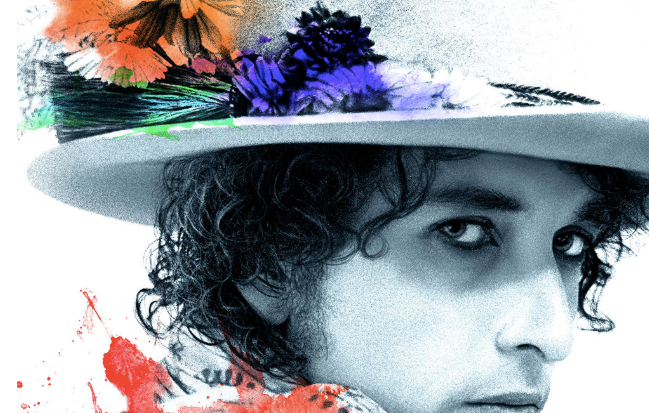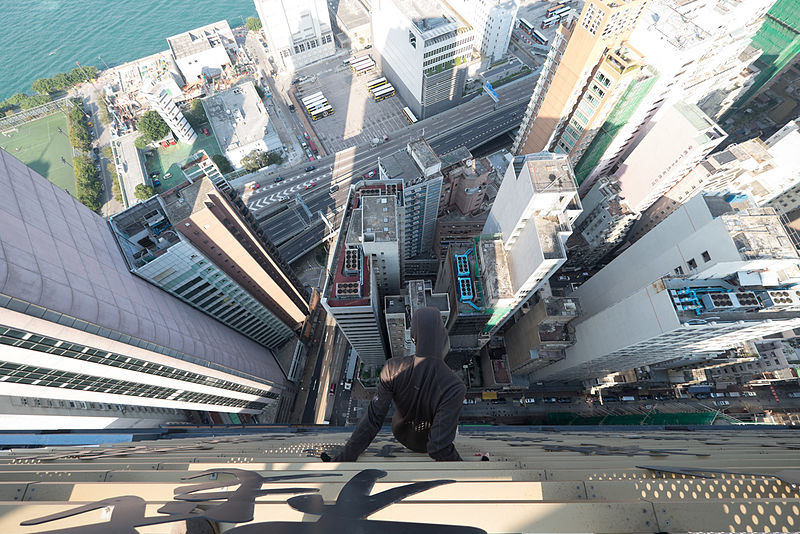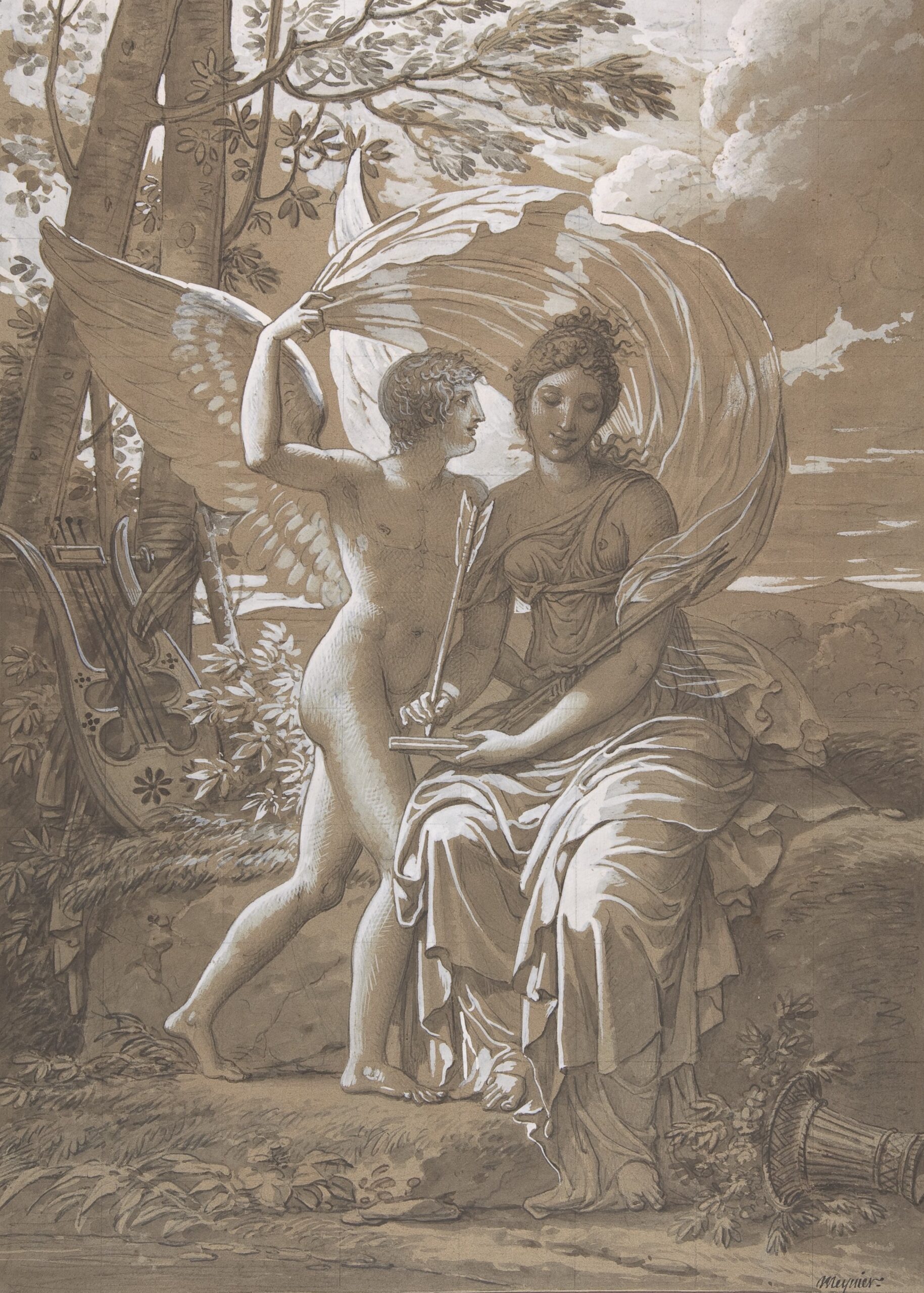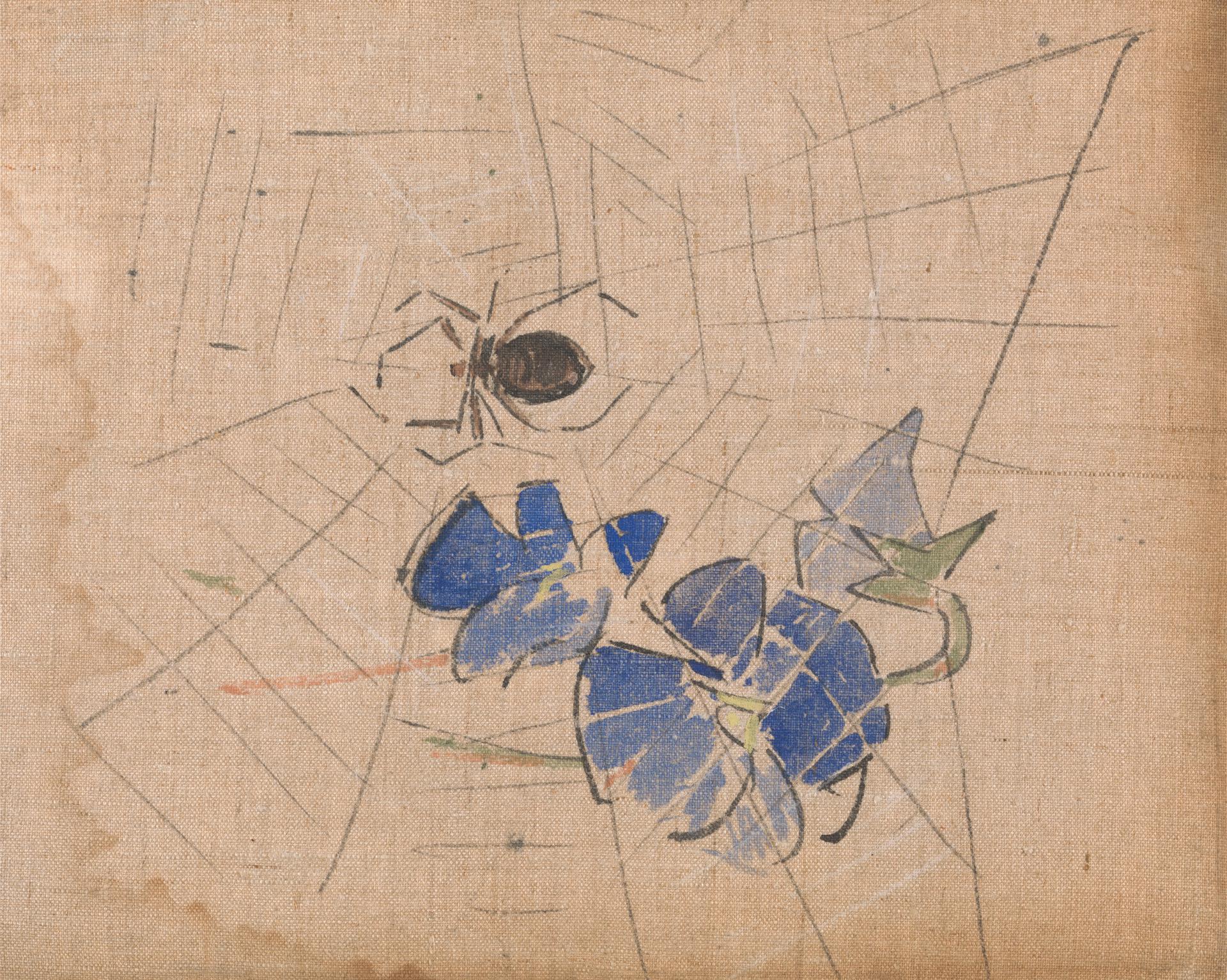1.
Martin Scorsese’s new film, Rolling Thunder Revue: A Bob Dylan Story, starts with a vanishing act. A man in a top-hat drapes a patterned sheet over a woman in a chair. When he flicks the sheet away, she’s gone. Now you see her, now you don’t. It’s a scene from Marcel Carné’s Les Enfants du Paradis, and it makes a fine beginning for a film wreathed in a ton of tricks and tall tales.
Rolling Thunder Revue is about a ramshackle tour that Bob Dylan cobbled together in 1975 and called the Rolling Thunder Revue. He assembled a few dozen musicians, poets, filmmakers, and friends, and took them on the road. He had Allen Ginsberg along, and Ramblin’ Jack Elliott, T Bone Burnett, Sam Shepard, Roger McGuinn (from The Byrds), Mick Ronson (from David Bowie’s Spiders from Mars), and the poet Anne Waldman; and Joan Baez joined the tour, and Joni Mitchell did, and Patti Smith made an appearance. They played small venues in small towns with little advance notice. Onstage, they wore costumes and masks and painted their faces. And they made tremendous music—vital and wild—with Dylan gesticulating at the center.
Scorsese uses concert footage, backstage footage, interviews with the central and not-so-central players, newsreel clips, and anything else he fancies, for a film very much in the spirit of its subject. Which is to say that all sorts of things have been fabricated, exaggerated, or entirely invented.
In the beginning, Dylan, in a recent interview, tries to describe the idea of the tour. “I wouldn’t say it was a traditional revue,” he says, “but it was in the, uh, traditional, um…form of a revue.” He’s bored by his own explanation. Then he bites off his own sentence: “That’s all clumsy bullshit.”
It is! Most of his bullshit—in this interview, onstage during Rolling Thunder, and throughout his entire career—has been much less clumsy. His bullshit has been playful, charming, petulant, coy, and occasionally—but only occasionally—spiteful. It has something to do with what seems to be his twin impulses: to perform, but also to shield himself from the gaze of strangers.
“I’m trying to get to the core of what this Rolling Thunder thing is all about,” he tells Scorsese, “and I don’t have a clue, because it’s about nothing. It’s just something that happened 40 years ago. And that’s the truth of it.”
The truth of what? Dylan—and the film as a whole—spins a hell of a lot of delightful nonsense. The thing that’s genuine and true wavers behind and in-between all the riddles and bluffs, the hats and feathers and flowers, the silks and scarves and shrouds and masks and paint. It’s tempting to say that the pretense is what allows him to be honest, to expose something vulnerable—but who can say if that’s true? It stinks of pop psychology.
Here is what I want to say: in Rolling Thunder Revue, Scorsese does what Dylan has been doing for decades, which is to create a storm of illusion, allusion, irony, disguise, humor, and falsehood to express something crucial and raw and exquisitely moving.
2.
 In 2005, Harry G. Frankfurt, philosopher emeritus at Princeton, published a slim little book, On Bullshit. “Someone who lies and someone who tells the truth,” he explains, “are playing on opposite sides, so to speak, in the same game. Each responds to the facts as he understands them.” The latter adheres to the truth; the former defies it. Then there’s the bullshitter. The bullshitter “is neither on the side of the true nor on the side of the false. His eye is not on the facts at all,” Frankfurt writes. “He does not care whether the things he says describe reality correctly. He just picks them out, or makes them up, to suit his purpose.”
In 2005, Harry G. Frankfurt, philosopher emeritus at Princeton, published a slim little book, On Bullshit. “Someone who lies and someone who tells the truth,” he explains, “are playing on opposite sides, so to speak, in the same game. Each responds to the facts as he understands them.” The latter adheres to the truth; the former defies it. Then there’s the bullshitter. The bullshitter “is neither on the side of the true nor on the side of the false. His eye is not on the facts at all,” Frankfurt writes. “He does not care whether the things he says describe reality correctly. He just picks them out, or makes them up, to suit his purpose.”

 Here’s what’s real in Rolling Thunder Revue: the concert footage, the performances, the songs. During the tour, Dylan played songs from Blood on the Tracks, which had just been released, and songs from Desire, which was about to be released; and he played traditional songs, and songs from the very beginning of his career. He’s as thin as a reed in a white shirt, black vest, pants slung low across his hips, a spray of flowers stuffed in his hat-band—roses, carnations, wildflowers, baby’s breath. His voice is sometimes playful, sometimes plaintive. He played breathtaking acoustic versions of “Mr. Tambourine Man,” and “It’s All Over Now, Baby Blue,” and “Love Minus Zero / No Limit,” alone on the stage, his face painted or masked, his voice urgent and raw.
Here’s what’s real in Rolling Thunder Revue: the concert footage, the performances, the songs. During the tour, Dylan played songs from Blood on the Tracks, which had just been released, and songs from Desire, which was about to be released; and he played traditional songs, and songs from the very beginning of his career. He’s as thin as a reed in a white shirt, black vest, pants slung low across his hips, a spray of flowers stuffed in his hat-band—roses, carnations, wildflowers, baby’s breath. His voice is sometimes playful, sometimes plaintive. He played breathtaking acoustic versions of “Mr. Tambourine Man,” and “It’s All Over Now, Baby Blue,” and “Love Minus Zero / No Limit,” alone on the stage, his face painted or masked, his voice urgent and raw.
Scorsese includes a blistering performance of “Isis,” Dylan seeming to rise somehow outside of his own skin and to flicker there, above it. His eyes flash under his hat-brim; the paint melts off his face. It’s rare for him to sing without a guitar or a piano—some barricade—between himself and the audience, but he sings “Isis” empty-handed, gesturing wildly.
Since the film’s release, certain corners of the Internet have gone abuzz over what’s true and what isn’t, and whether it matters (Rolling Stone even published a handy little guide). Here’s what’s fake: Stefan van Dorp, who supposedly shot all this footage for a film of his own, and is interviewed extensively, is a fictional character. Outside of the film, he doesn’t exist. (Neither does “Rep. Jack Tanner,” who appears later, claiming Jimmy Carter got him in to see Rolling Thunder in Niagara Falls.)
Actually, Dylan had hired several filmmakers to follow Rolling Thunder, and shoot the shows, along with improvised scenes between Dylan and whoever else happened to be around, for a film of his own, called Renaldo and Clara: a four-hour-long muddle of concert and interview footage and “dramatic” scenes more or less based on Dylan’s life. Bob Dylan plays “Renaldo;” Ronnie Hawkins plays “Bob Dylan;” Ronee Blakley plays “Mrs. Dylan;” Allen Ginsberg plays “The Father,” and etc., etc.
3.
Dylan was magnificent onstage during Rolling Thunder. It’s hard to find the right adjective. Arresting? Commanding? He sounds present in a way he doesn’t, always, in performance. He can sound distant, like he isn’t really there, or not quite.
But it isn’t just that: He’s generous with the musicians around him, and sometimes there’s a crowd. You see him responding to them, to their playing—sometimes with exaggerated, mime-like gestures, and sometimes with minutely realized inflections in his voice. His affinity for the marvelous, enigmatic Scarlet Rivera is especially moving. Most nights she stood to his right, her wild violin driving each song. You see their eyes meet again and again and again.
And he performed with Joan Baez throughout the tour. One night, as they’re alone on stage, and Dylan tunes up to play “I Shall Be Released,” some schmuck from the audience shouts, “What a lovely couple!” “Couple of—couple of what?” Baez says. She lays her hand on the back of his neck and leaves it there as they start to sing.
“Everything is forgiven,” Baez says in a recent interview, “whenever I see Bob sing.”
Through most of that interview, she seems pretty wary—whether she’s sick of the press, or sick of Dylan, or sick of the whole endeavor, who could say? “Any idea why he’d wear a mask?” she is asked. “Are you being funny?” she says.
4.
And then there are the hangers-on, who snuffle at the margins of both the tour and the film. Larry “Ratso” Sloman was an obsequious little slimeball ostensibly reporting on Rolling Thunder for Rolling Stone. He was apparently at pains to dress like Dylan, and was enormously pleased to be mistaken for Dylan. He managed to “interview” Dylan a few times, and Scorsese plays a few of his tapes: Ratso sounds aggressive, abrasive, and Dylan sounds sleepy and, as always, deflective.
Ronee Blakley sang back-up. When asked who on the tour she felt closest to, Blakley claims she felt closest to “Bob.” Really? You get the sense that all these people are playing out their own strange desires and regrets—and there’s Dylan, deadpan, right in the middle.
Then there’s Allen Ginsberg, embodying his own particular pathos: to be a poet when he would have liked to play music—or to be himself when he would have liked to be someone else. “There was this yearning,” Anne Waldman says, “Allen’s yearning, to either be Bob or have Bob love him.” “He was his own kind of king,” Dylan says, “but he wanted to play music.” Poor, pathetic Ginsberg bumbles about and when his set is inevitably cut from the show, somehow winds up (with his partner, Peter Orlovsky) carting the luggage (“You’re the fucking luggage handler?!” says Ratso).
“It was like having,” says Jack Elliott, “kind of like a father figure.”
“No,” Dylan says. “Allen Ginsberg was anything but a father figure.” He looks up at the ceiling. “He was definitely not a father figure.”
5.
Once you realize van Dorp is a fiction, of course, you have to reinterpret everything he’s said. “It was like looking into a mirror,” van Dorp says at one point. “You either saw what you wanted to see or you hated what you saw.” This may or may not be true, but who’s actually saying it? And who wants us to hear it? It could be what Scorsese wants to say about Dylan; it could also be Scorsese’s way of mocking what’s already been said about Dylan.
The film has other things to say about Dylan, and it says them—circuitously, or not so circuitously. In one scene, Ratso sits in a diner with a couple of people who aren’t introduced. “I thought it was so depressing,” one says, “that people would stand in line for two days to see a man. It just shows they have that need for something, like somebody to—bring salvation, or something. You know?” She looks at Ratso. “But I did it, too.”
Dylan himself says all sorts of things—in this film, and everywhere else he appears. For every seemingly revealing remark he’s ever made, he’s made another that’s entirely contradictory. This is the game he’s played throughout his career. He deflects attention from himself; he evades, distorts, and falsifies the truth. The truth, if it’s anything, is a scrap of light caught in an endless series of mirrors all reflecting each other.
“Life isn’t about finding yourself—or finding anything,” he says at one point. “Life is about creating yourself. And creating things.” And, at another point: “When someone is wearing a mask, he’s gonna tell you the truth. When he’s not wearing a mask,” he says, “it’s highly unlikely.”
I guess this is what makes him so maddening to people who find him maddening.
“That’s the first rule, the basic rule,” Dylan tells Ratso in one of Ratso’s tapes. “If you have expectations, if you have big expectations, you’re gonna be left out. You can’t have any expectations.”
“But people do,” Ratso says.
“That’s their problem, Ratso. That’s their own problem. We can’t account for everyone that’s walking around, you know, having expectations.”
6.
Dylan wasn’t the only one on Rolling Thunder to wear a mask. David Mansfield points out that Jack Elliott, in his cowboy clothes and drawl, was a Jewish dentist’s son from Brooklyn. Dylan wasn’t even the only one to masquerade as Bob Dylan. Ratso started dressing like Dylan; so did Joan Baez; and McGuinn took to singing the second verse of “Knockin’ On Heaven’s Door” in an eerily accurate rendition of Dylan’s voice.
“We didn’t have enough masks on that tour,” Dylan says. “We should have had masks for everybody.”
“Mr. Tambourine Man,” says Scarlet Rivera, “gives us the opportunity to be whoever we wish to be.”
7.
Bruce Springsteen has spent the last few years performing intimate versions of his songs, and candid stories about his life, on Broadway (and in a Netflix special of his own). It’s pretty funny to consider Rolling Thunder Revue in that context. This is Dylan’s—and Scorsese’s—performance of intimacy. It leaves out any mention of what might have been happening in Dylan’s life at the time. It includes a lot of falsehoods. In the end, and taken as a whole, it’s hilarious, and it’s breathtaking.
“I don’t remember a thing about Rolling Thunder,” Dylan says. “I mean, it happened so long ago I wasn’t even born.”
Rolling Thunder was a world that he conjured for a number of months—conjured, peopled, costumed, and then packed up and toted away. It was a world something like Marianne Moore’s imaginary garden inhabited by real toads.
At one point, Scorsese shows footage of the end of a Rolling Thunder show. The camera has ventured out into the audience. The curtain has come down, the lights have gone up, and a girl stands in the aisle, dazed, a hand cupped across her face. Then, abruptly, she bursts into tears.
“I’m mortified to be on the stage,” Dylan told an interviewer in 1997, “but then again, it’s the only place where I’m happy. It’s the only place you can be who you want to be.”
Does he mean that? Maybe he does, maybe he doesn’t. This is the Scylla and Charybdis, if you will, of trying to understand Dylan—of trying to understand anyone. You can neither trust nor discount—not entirely—anything he says. Whether he masquerades to amuse himself or to protect himself, or neither, or both, or something else entirely, doesn’t matter all that much. I’m mixing my metaphors, my references, but: the play’s the thing. Or the show is. And what a show it’s been.












